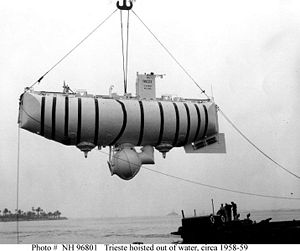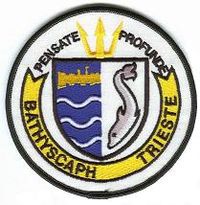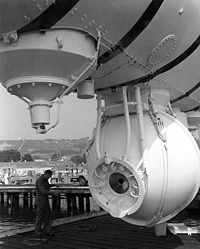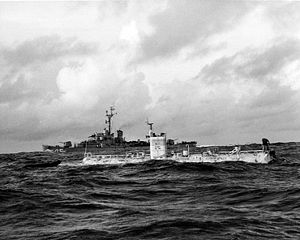- Bathyscaphe Trieste
-

Career (Italy) 
Name: Trieste Builder: Acciaierie Terni/Cantieri Riuniti dell'Adriatico Launched: 26 August 1953 Fate: Sold to the United States Navy, 1958 Career (USA) 
Name: Trieste Acquired: 1958 Decommissioned: 1966 Reclassified: DSV-0, 1 June 1971 Fate: Preserved as an exhibit in the U.S. Navy Museum Badge: General characteristics Type: Bathyscaphe Displacement: 50 long tons (51 t) Length: 59 ft 6 in (18.14 m) Beam: 11 ft 6 in (3.51 m) Draft: 18 ft 6 in (5.64 m) Complement: 2 The Trieste is a Swiss-designed, Italian-built deep-diving research bathyscaphe ("deep boat") with a crew of two, which reached a record maximum depth of about 10,911 metres (35,797 ft), in the deepest known part of the Earth's oceans, the Challenger Deep, in the Mariana Trench near Guam, on January 23, 1960, crewed by Jacques Piccard (son of the boat's designer Auguste Piccard) and U.S. Navy Lieutenant Don Walsh achieving the goal of Project Nekton.
Trieste remains the only manned vessel to have reached the bottom of Challenger Deep. The vessel is currently on display at the U.S. Navy Museum.
Contents
Design
The Trieste was designed by the Swiss scientist Auguste Piccard and built originally in Italy. His pressure sphere, composed of two sections, was built by the company Acciaierie Terni, and the upper part was manufactured by the company Cantieri Riuniti dell'Adriatico, in the Free Territory of Trieste (on the border between Italy and Yugoslavia); hence that name was chosen for the bathyscaphe. The installation of the pressure sphere was done in the Cantiere navale di Castellammare di Stabia, near Naples. The Trieste was launched on 26 August 1953 into the Mediterranean Sea near the Isle of Capri. The design was based on previous experience with the bathyscaphe FNRS-2, also designed by the Piccards. (It was built in Belgium). Trieste was operated by the French Navy. After several years of operation in the Mediterranean Sea, the Trieste was purchased by the United States Navy in 1958 for $250,000.
The Trieste consisted of a float chamber filled with gasoline for buoyancy, with a separate pressure sphere. This configuration (dubbed a bathyscaphe by the Piccards) allowed for a free dive, rather than the previous bathysphere designs in which a sphere was lowered to depth and raised from a ship by cable.
At the time of Project Nekton, the Trieste was more than 15 m (50 ft) long. The majority of this was a series of floats filled with 85,000 litres (22,000 US gal) of gasoline, and water ballast tanks were included at either end of the vessel, as well as releasable iron ballast in two conical hoppers along the bottom, fore and aft of the crew sphere. The crew occupied the 2.16 m (7.09 ft) pressure sphere, attached to the underside of the float and accessed from the deck of the vessel by a vertical shaft that penetrated the float and continued down to the sphere hatch.
In the Trieste the pressure sphere provided just enough room for two people. It provided completely independent life support, with a closed-circuit rebreather system similar to that used in modern spacecraft and spacesuits: oxygen was provided from pressure cylinders, and carbon dioxide was scrubbed from breathing air by being passed through canisters of soda-lime. Power was provided by batteries.
The Trieste was later fitted with a new pressure sphere, manufactured by the Krupp Steel Works of Essen, Germany (a company that had produced well over 100 U-boats during World War II) in three finely-machined sections (an equatorial ring and two caps). To withstand the great pressure of 1.25 metric tons per cm² (110 MPa) at the bottom of Challenger Deep, the sphere's walls were 12.7 centimetres (5.0 in) thick (it was overdesigned to withstand considerably more than the rated pressure). The sphere weighed 13 metric tons in air and eight metric tons in water (giving it an average specific gravity of 13/(13-8) = 2.6 times that of sea water). The float was necessary because of the sphere's density: it was not possible to design a sphere large enough to hold a person that would withstand the necessary pressures, yet also have metal walls thin enough for the sphere to be neutrally-buoyant. Gasoline (petrol) was chosen as the float fluid because it is less dense than water, yet relatively incompressible even at extreme pressure, thus retaining its buoyant properties and negating the need for thick, heavy walls for the float chamber.
Observation of the sea outside the craft was conducted directly by eye, via a single, very tapered, cone-shaped block of acrylic glass (Plexiglas), the only transparent substance identified which would withstand the pressures needed, at the design hull thickness. Outside illumination for the craft was provided by quartz arc-light bulbs, which proved to be able to withstand the over 1000 atmospheres of pressure without any modification.
Nine tons of magnetic iron pellets were placed on the craft as ballast, both to speed the descent and allow ascent, since the extreme water pressures would not have permitted compressed air ballast-expulsion tanks to be utilized at great depths. This additional weight was held in place actively at the throats of two hopper-like ballast silos by electromagnets, so that in case of an electrical failure the bathyscaphe would rise automatically to the surface.
Transported to the Naval Electronics Laboratory's facility in San Diego, the Trieste was modified extensively by the Americans, and then used in a series of deep-submergence tests in the Pacific Ocean during the next few years, culminating in the dive to the bottom of the Challenger Deep in the Mariana Trench, the deepest part of the ocean, during January 1960.
The Mariana Trench dives
Trieste departed San Diego on October 5, 1959 for Guam aboard the freighter Santa Maria to participate in Project Nekton, a series of very deep dives in the Mariana Trench. On January 23, 1960, Trieste[1] reached the ocean floor in the Challenger Deep (the deepest southern part of the Mariana Trench), carrying Jacques Piccard (son of Auguste) and U.S. Navy Lieutenant Don Walsh. This was the first time a vessel, manned or unmanned, had reached the deepest known point of the Earth's oceans. The onboard systems indicated a depth of 11,521 metres (37,799 ft), although this was revised later to 10,916 metres (35,814 ft) and more accurate measurements made during 1995 have found the Challenger Deep to be slightly shallower, at 10,911 metres (35,797 ft).
The descent to the ocean floor took 4 hours and 48 minutes at a descent rate of 0.9 metres per second (3.0 ft/s).[1][2] After passing 9,000 meters one of the outer Plexiglas window panes cracked, shaking the entire vessel.[3] The two men spent barely twenty minutes at the ocean floor, eating chocolate bars for sustenance. The temperature in the cabin was a mere 7°C (45°F) at the time. While on the bottom at maximum depth, Piccard and Walsh unexpectedly regained the ability to communicate with the surface ship, USS Wandank (ATA-204), using a sonar/hydrophone voice communications system.[4] At a speed of almost a mile per second (about five times the speed of sound in air), it took about seven seconds for a voice message to travel from the craft to the surface ship and another seven seconds for answers to return.
While on the bottom, Piccard and Walsh observed a number of small sole and flounder swimming away[citation needed], proving that at least some vertebrate life can withstand the extremes of pressure in the Earth's oceans. They noted that the floor of the Challenger Deep consisted of "diatomaceous ooze". The ascent to surface took 3 hours, 15 minutes.
Since then, no manned craft has ever returned to the Challenger Deep. A Japanese robotic craft Kaikō reached the bottom of the Challenger Deep in 1995. The Nereus hybrid remotely operated vehicle (HROV) reached the bottom on May 31, 2009.[5]
Other deep dives by Trieste
Beginning April 1963, Trieste was modified and used in the Atlantic Ocean to search for the missing submarine USS Thresher (SSN-593). In August 1963, Trieste found the wreck off the coast of New England, 8,400 feet (2.56 km) below the surface.[6] Trieste was changed, improved and redesigned so many times that almost no original parts remain. The Trieste was transported to the Washington Navy Yard where it was exhibited along with the Krupp pressure sphere in the National Museum of the U.S. Navy at the Washington Navy Yard in 1980. Her original Terni pressure sphere was incorporated into the Trieste II.
See also
References
- ^ NGC: On the sea floor
- ^ To the Depths in Trieste, University of Delaware College of Marine Studies
- ^ Seven Miles Down: The Story of The Bathyscaph Trieste., Rolex Deep Sea Special, Written January 2006.
- ^ "Wandank (ATA-204)". historycentral.com. http://www.historycentral.com/navy/Tug/Wanduck%20II.html. Retrieved 2009-06-03.
- ^ "Robot sub reaches deepest ocean". BBC News. 3 June 2009. http://news.bbc.co.uk/2/hi/science/nature/8080324.stm. Retrieved 2009-06-03.
- ^ Brand, V (1977). "Submersibles - Manned and Unmanned". South Pacific Underwater Medicine Society Journal 7 (3). ISSN 0813-1988. OCLC 16986801. http://archive.rubicon-foundation.org/6154. Retrieved 2008-07-10.
Further reading
- Piccard, Jacques and Dietz, Robert S. (1961). Seven Miles Down; The Story of the Bathyscaph Trieste. G. T. Putnam's Sons.
Tribute
The song 'The Trench' by Danish composer Ste van Holm is a tribute to the Mariana Trench dives.
External links
- US Navy - Trieste
- Animation of Trieste
- HNSA Ship Page: RV Trieste
- History of the Bathyscaphe Trieste
- 50th anniversary recollection by retired Navy Captain Don Walsh.
- 2008 obituary of diver Jaques Piccard
- Seven Miles Down the story of the Bathyscaphe Trieste
Extremes of motion Speed Air (transcontinental) · Land (railed · production car · special motorcycle · production motorcycle ) · Water (underwater · transatlantic) · SpaceDistance See also Categories:- Trieste class DSV
- Submarines of the United States Navy
- Submarines of Italy
- Swiss inventions
- Museum ships in Washington, D.C.
- Ships preserved in museums
- 1953 ships
- Unique submarines
Wikimedia Foundation. 2010.





